Clothes Line Culture: the Art and Intention of Hanging Laundry
There’s something sacred about the quiet rhythm of pinning up a line of freshly washed laundry. The sun warming your back, the birdsong overhead, the faint scent of soap and soil clinging to damp cotton—it’s an old kind of peace. One you can’t rush.
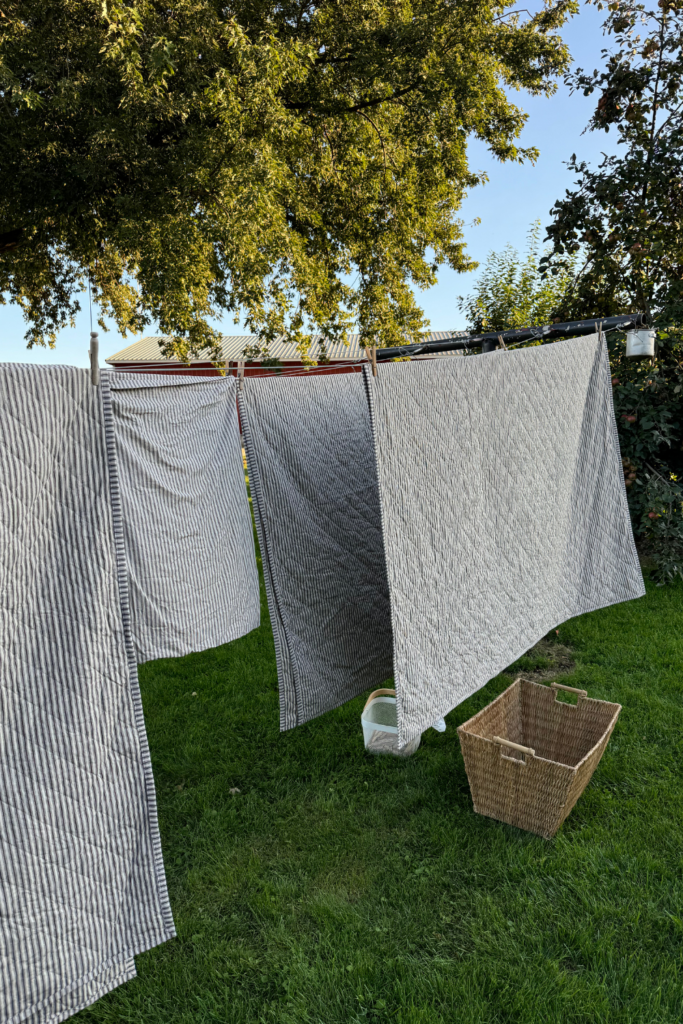
An Intentional Practice
In our home, the clothesline is more than a place to dry socks and cotton sheets—it’s a seasonal rhythm. Despite hating this chore when I was a kid, it was the first thing I wanted to install in our yard when we moved our family to the farm. A ritual. A thread that ties our daily work to the wind and the weather. And somehow, over the years, it’s become one of my favorite forms of slow living.
- The ritual of hanging your clothes
- A connection to nature
- Why we continue to use a drying line
- My go-to laundry detergent recipe
- Tips to start your clothes line journey
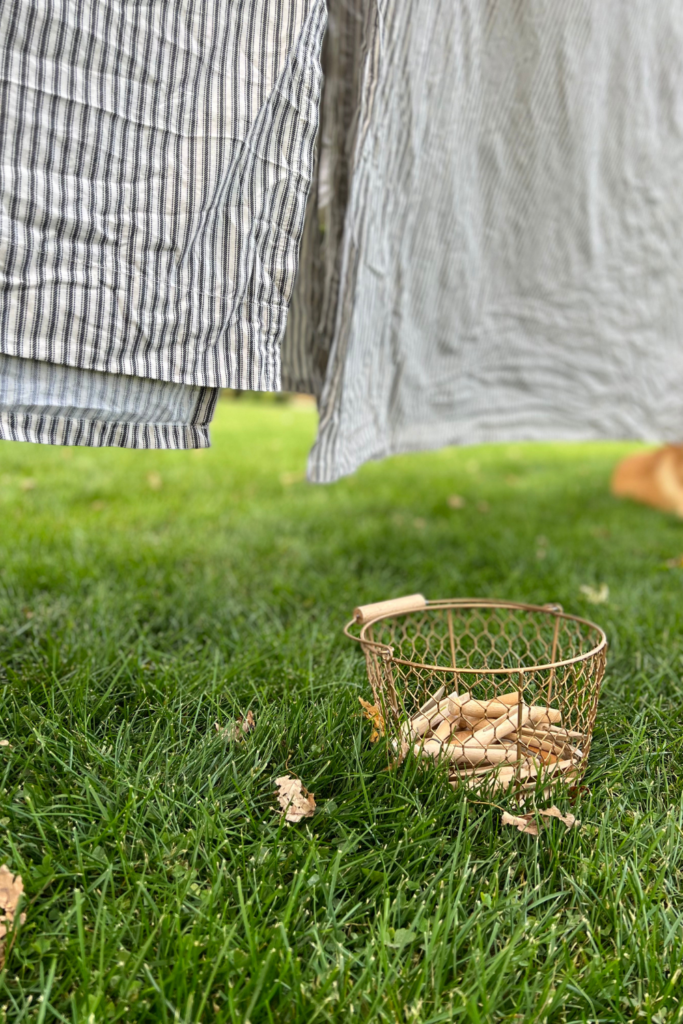
More Than Drying Clothes—It’s a Ritual
Hanging laundry by hand takes time. It demands a kind of presence that a tumble dryer never asks of us. It’s the kind of slowness I crave in a world that constantly pushes us to multitask and move on.
On summer mornings, I’ll often start the day by carrying a basket outside, trailing little feet behind me, and sharing the task of pinning up tea towels, overalls, and pillowcases with whoever is nearby. Some of my favorite conversations have happened over a flapping clothesline.
We don’t do it because we have to. We do it because it feels good to touch each item, to smooth it out and give it space to breathe. It’s how I care for what we wear and use. It’s also a small way of teaching stewardship—through repetition and tenderness.
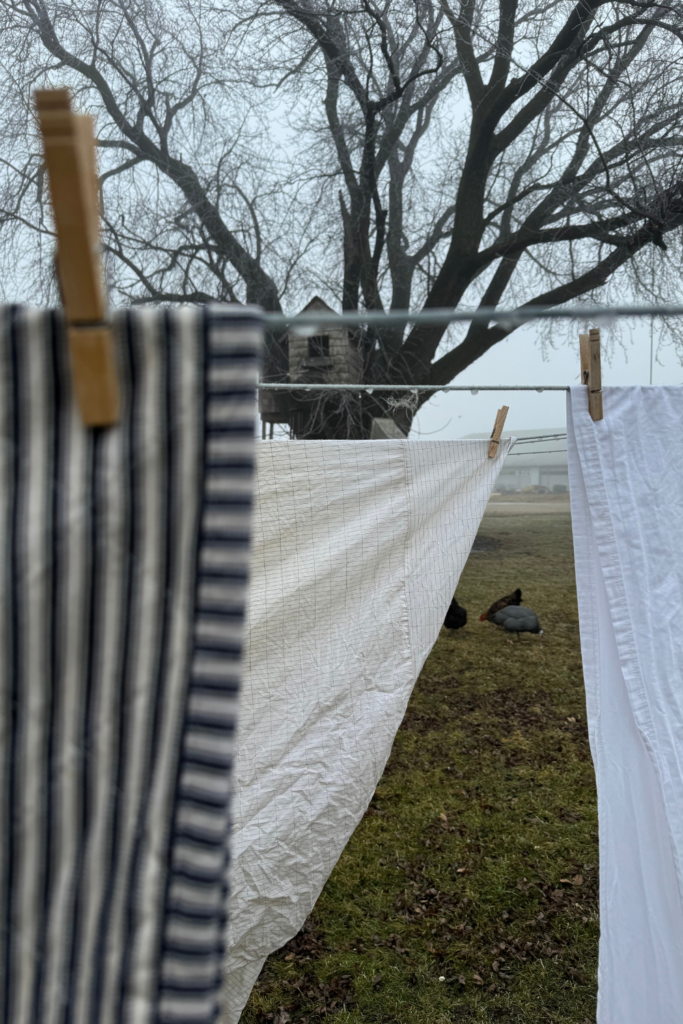
A Connection to Nature and Seasonality
The line tells me what season it is. In spring, everything dries crisp and quick under a soft breeze. In high summer, it smells like sweetgrass and sun. In fall, I chase the last bits of warmth before the frost sets in. Even in winter, I’ll sometimes hang heavier things in the cold and marvel at how they freeze into stiff shapes before thawing dry by the stove. At least once a year I take our wool hides and clean them with the fresh snow on the ground – this is a Nordic tradition called “snow washing” or “snötvätt”. Afterwards, I let them hang out on the line.
Line-drying makes you aware of the weather in a way that plugging in a machine never will. You learn to watch the skies. You know the feeling of laundry being “just right”—not too wet, not too stiff. It slows your pace. It brings you outside.
Why we continue to use a Drying Line
Utility and Simplicity
Yes, it saves energy and money. Yes, it’s gentler on our clothes. But it’s more than that—it just fits. It fits how we live. It’s quiet. It’s steady. It never breaks down. The clothesline is one of those practical tools that supports the kind of home I want to run: one that values simple solutions, self-sufficiency, and beauty in the ordinary.
I’m a utilitarian at heart, and hanging laundry is deeply utilitarian—but it’s also unexpectedly romantic. It’s a pause button in the middle of a busy day. A way to stretch, breathe, and reflect.
Passing It On
The clothesline has become a quiet teacher in our family. My kids know the drill. They help shake things out, match up clothespins, and sometimes they just run between the sheets like it’s their secret fort. They’ll remember this, I think. The feeling of being part of something slow and grounded. Something handed down.
A clothesline isn’t just wires and poles. It’s a symbol—of care, of presence, of choosing a life that doesn’t always reach for the fastest option.
So maybe this week, instead of tossing everything into the dryer, you take a little time and hang it out. Even if that means over a folding chair on the lawn or your deck railing. Let the sun do its work. Let the wind be your helper. Let the moment be a still one.
And when the linens are dry, breathe deep. That scent? That’s what clean really smells like.
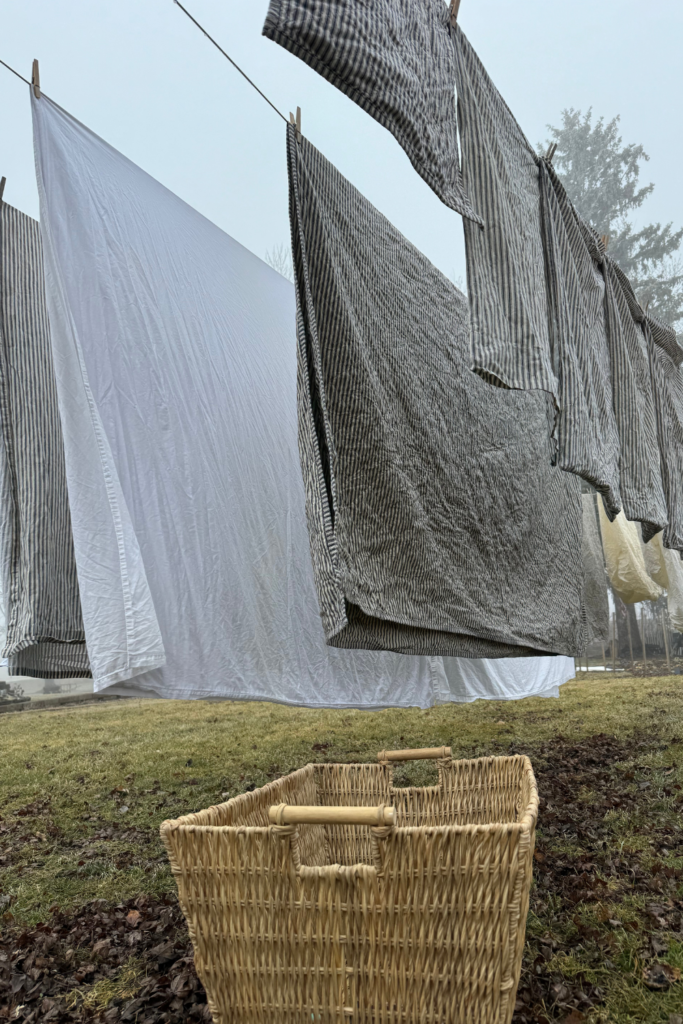
The Best Sleep Money Can’t Buy
There’s nothing quite like the smell of line-dried laundry coming in off the line. It’s not just clean—it’s fresh, like wild clover, sunlight, and wind. No bottled fragrance can touch it. Believe me, they’ve tried!
Tucking into crisp, sun-dried sheets at the end of the day feels like slipping into a soft summer breeze. It’s grounding. It’s wholesome. It’s everything I remember from being a kid. Working on the farm, outside all day long, then coming in to the best treat ever. Fresh line-dried sheets and a summer strawberry dessert. And it’s the best night’s sleep money can’t buy.
We chase a lot of comforts in this life—but sometimes the richest ones are hanging quietly on the line, waiting to be folded.
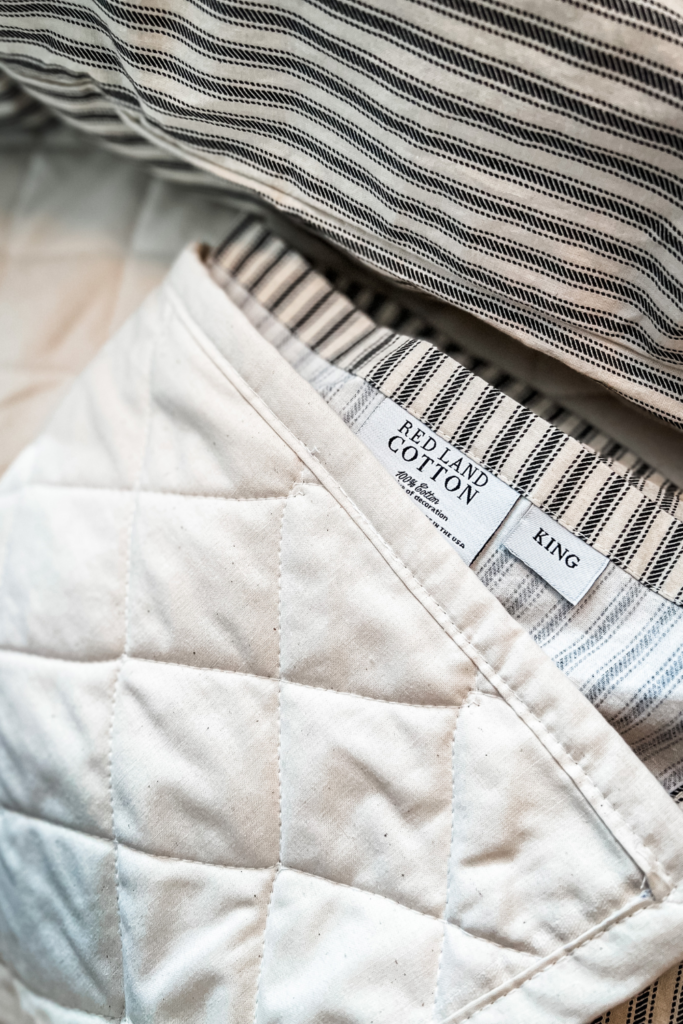
We have been using Red Land Cotton’s amazing, All-Cotton Bedding and Quilts for years now! The quality is amazing and we are happy to support American-made businesses like this one!
My Go-To DIY Laundry Soap Recipe
If you’ve never made your own laundry soap before, you’ll be surprised at how easy (and satisfying) it is. This recipe is simple, effective, and gentle on both clothes and skin. Plus, it pairs beautifully with a line-drying routine—no artificial fragrances, just clean clothes and fresh air.
What You’ll Need:
- 1 bar of Castile soap (or homemade tallow soap, grated)
- 1 cup washing soda (sodium carbonate)
- 1 cup borax (optional – leave out for a more sensitive formula)
- Optional: 15–20 drops of essential oil (like lavender, lemon, or tea tree)
Instructions:
- Grate the soap finely using a cheese grater or food processor.
- In a large mixing bowl or container, combine grated soap, washing soda, and borax (if using).
- Add essential oil drops and stir well to combine.
- Store in an airtight container. A mason jar, large crock, or lidded bucket all work well. I like using this jar with a spout.
To Use:
- Add 2–3 tablespoons per load for a top loader.
- Use 1–2 tablespoons for an HE (high-efficiency) machine.
- For extra boost on heavy soil loads, I add ½ cup of white vinegar to the rinse cycle.
Tip:
For a fully natural routine, skip fabric softeners and use wool dryer balls (or hang dry, of course!)—they last for years and help soften clothes without synthetic scents.
Homemade Laundry Soap
Ingredients
- 1 bar Castile soap (or homemade tallow soap, grated)
- 1 cup Washing soda sodium carbonate
- 1 cup Borax (optional – leave out for a more sensitive formula)
- 15-20 drops Essential Oil (optional: lavender, lemon, tea tree, etc.)
Instructions
How to Make
- Grate the soap finely using a cheese grater or food processor
- In a large mixing bowl or container, combine grated soap, washing soda, and borax (if using)
- Add essential oil drops and stir well to combine.
- Store in an airtight container. A mason jar, large crock, or lidded bucket all work well. I like using this jar with a spout.
How to Use
- Add 2–3 tablespoons per load for a top loader.
- Use 1–2 tablespoons for an HE (high-efficiency) machine.
- For extra boost on heavy soil loads, I add ½ cup of white vinegar to the rinse cycle.

Tips to start Air Drying your Laundry
Choosing the right spot
As you would with planning your garden, figure out the best place to set up accessible and effective drying lines. This means considering how much airflow and sunlight your chosen spot will get. Try to pick a spot that has enough room on each side to let the sheets and laundry flow freely without bumping into trees or other greenery in your yard. Consider which direction the wind generally blows and also how far away from your laundry room this would be. Our laundry, for instance is right off of our garage, so we can easily, plop our wet laundry into a basket and head outside.
Buying the right material
In order to make sure our clothes line set up is durable (and it has been!) we strung rubber coated clothes line and attached to cast iron poles dug into the ground.
Invest in quality clothes pins
Often times we are hanging our heavy sheets which requires a clothespin that ensures our clean sheets won’t end up on the ground (that would be a different level of grounding!). I love my grandmas vintage clothes pins that look like this. We also have a collection of these wooden ones, too.
Watch the weather
Keep an eye on the skies! We already live by the forecast in our family, especially this time of year. I rely on whatever the clouds have brewing up in the sky to plan out our weeks – and this extends to laundry. When I’m ready to hang my clothes out to dry, the sky isn’t always on the same page. I don’t see this as a disadvantage, though, it’s just another way we stay in tune with and connected to nature’s trends.
Pin for Later!

More Farm Living Posts
How to create bi-fold closet doors for less

Affiliate Disclosure & Content Disclaimer
This post may contain affiliate links from a paid sponsor, Amazon or other program. When you use these links to make a purchase I earn a small commission at no extra cost to you. This allows me to continue creating the content that you love. The content in this article is created for information only and based on my research and/or opinion.
Emily T.
DAILY INSPIRATION ON THE GRAM @hearty.sol
it's hip to be square!
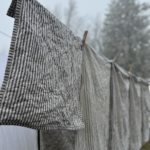
View comments
+ Leave a comment